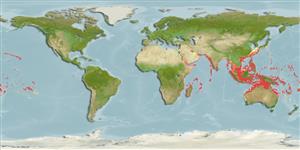Common names from other countries
>
Eupercaria/misc (Various families in series Eupercaria) >
Lutjanidae (Snappers) > Etelinae
Etymology: Aphareus: Greek, aphareys, -eos = water wings under the belly of female tunna (Ref. 45335).
More on author: Lacepède.
Environment: milieu / climate zone / depth range / distribution range
Ekologi
laut berasosiasi dengan karang; kisaran kedalaman 0 - 122 m (Ref. 9710). Tropical; 35°N - 31°S, 35°E - 134°W (Ref. 55)
Indo-Pacific: East Africa to the Hawaiian Islands, north to southern Japan, south to Australia. Reported from Cocos Island in the eastern Pacific (Ref. 9821).
Size / Weight / umur
Maturity: Lm ? range ? - ? cm
Max length : 70.0 cm TL jantan/; (Ref. 5484); common length : 25.0 cm SL jantan/; (Ref. 9821); Berat maksimum terpublikasi: 906.00 g (Ref. 4887)
Duri punggung (Keseluruhan (total)) : 10; duri punggung lunak (Keseluruhan (total)) : 10 - 11; Duri dubur: 3; Sirip dubur lunak: 8.
Adults inhabit inshore coral and rocky reefs and in clear waters of lagoons (Ref. 9821). Pelagic and benthopelagic (Ref. 58302). Occur singly or in small groups. Feed mainly on fishes, but also eat crustaceans. Individuals with brilliant yellow on head may be nuptial males (Ref. 9821). Often curious and approachable (Ref. 9710). Marketed fresh. Minimum depth reported taken from Ref. 128797.
Life cycle and mating behavior
Maturities | Reproduksi, perkembang biakan | Spawnings | Egg(s) | Fecundities | Larva
Anderson, W.D. Jr. and G.R. Allen, 2001. Lutjanidae. Jobfishes. p. 2840-2918. In K.E. Carpenter and V. Niem (eds.) FAO species identification guide for fishery purposes. The living marine resources of the Western Central Pacific. Vol. 5. Bony fishes part 3 (Menidae to Pomacentridae). FAO, Rome. (Ref. 9821)
Status IUCN Red List (Ref. 130435)
CITES (Ref. 128078)
Not Evaluated
ancaman kepada manusia
Reports of ciguatera poisoning (Ref. 30298)
penggunaan manusia
Perikanan: komersial; Ikan buruan: ya
Alat, peralatan
laporan khas
muat turun XML
Sumber internet
Estimates based on models
Preferred temperature (Ref.
115969): 24.7 - 29.1, mean 28 (based on 1996 cells).
Phylogenetic diversity index (Ref.
82804): PD
50 = 0.7500 [Uniqueness, from 0.5 = low to 2.0 = high].
Bayesian length-weight: a=0.01738 (0.01020 - 0.02960), b=2.95 (2.81 - 3.09), in cm Total Length, based on LWR estimates for this species & (Sub)family-body (Ref.
93245).
Trophic level (Ref.
69278): 4.1 ±0.73 se; based on food items.
Daya lenting (Ref.
120179): sedang, Waktu penggandaan populasi minimum 1.4 - 4.4 tahun (tmax = 9).
Fishing Vulnerability (Ref.
59153): Moderate to high vulnerability (48 of 100).
